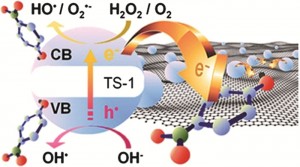A hybrid photocatalytic system, coupling a zeolite with graphene, has been developed by teams in the UK, India and Germany. This new system could have implications for important applications such as water and air purification, dye degradation, self-cleaning and anti-bacterial surfaces as well as various technical photosynthetic processes.
Dominik Eder at the University of Münster and colleagues at the University of Cambridge, used a titanosilicate zeolite (TS-1) with graphene incorporated, at varying concentrations, in its pores. TS-1 was chosen becasue of its good photocatalytic properties and graphene was chosen for its exceptional electrical and optical properties, along with its ability to accept electrons via photoexcitation.
The team found that the photocatalytic activity was greater when compared to TS-1 hybrids with carbon nanotubes.
Reference:
Hybridizing photoactive zeolites with graphene: a powerful strategy towards superior photocatalytic properties
Z Ren, E Kim, S W Pattinson, K S Subrahmanyam, C N R Rao, A K Cheetham nd D Eder, Chem. Sci., 2011
DOI:10.1039/c1sc00511a











